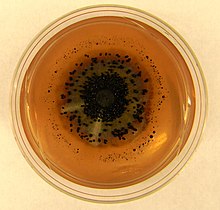Xylonomycetes
| Xylonomycetes | |
|---|---|

| |
| Four-week old culture of Xylona heveae growing on Potato dextrose agar | |
| Scientific classification | |
| Domain: | Eukaryota |
| Kingdom: | Fungi |
| Division: | Ascomycota |
| Class: | Xylonomycetes Gazis & P. Chaverri, 2012 [1] |
| Orders | |
The Xylonomycetes are a class of fungi,[2] which holds 2 orders of Symbiotaphrinales Baral & E. Weber,[3] and Xylonales Gazis & P. Chaverri.[4][5]
History[edit]
During a culture-based survey of living sapwood and leaves of rubber trees (Hevea spp.) in remote forests of Peru. Multilocus phylogenetic analyses reveal that this new lineage came from the radiation of the Leotiomyceta class which generated several other classes including Arthoniomycetes, Dothideomycetes, Eurotiomycetes, Geoglossomycetes, Lecanoromycetes, Leotiomycetes, Lichinomycetes and Sordariomycetes. Due to the unique morphological, physiological, and ecological traits relative to known endophytes, Xylonomycetes was deemed unique enough to be separate.[1]
Within the superclass of Pezizomycotina, the 6 classes (including Pezizomycetes and Orbiliomycetes) were monophyletic apart from Xylonomycetes. Xylonomycetes, Eurotiomycetes and Dothideomycetes were deemed to have had a single origin.[6]
They contain unspecific peroxygenases (UPO) enzymes which can be used to determine taxonomic afflication.[7]
It contains the wood endophytes in Xylona and the endosymbionts of beetles in Symbiotaphrina.[8] It has been suggested that these seeming unrelated genera might be linked via a yeast-like stage. As an asexual yeast living within the insect guts, with an asexual mycelial form and then a sexual form associated with the dead wood. Although, the frequency of transfer between free-living and symbiotic conditions is unknown and could be very low. As the yeasts are transferred vertically via the ovipositor of the female inset to the egg surface.[9]
Taxon[edit]
Xylonomycetes holds (orders and families);
- Symbiotaphrinales
- Symbiotaphrinaceae Baral & E. Weber, 2018[3]
- Xylonales
- Xylonaceae Gazis & P. Chaverri, 2012[1]
References[edit]
- ^ a b c Gazis, R.; Miadlikowska, J.; Lutzoni, F.; Arnold, A.E.; Chaverri, P. (2012). "Culture-based study of endophytes associated with rubber trees in Peru reveals a new class of pezizomycotina: Xylonomycetes". Molecular Phylogenetics and Evolution. 65: 294–304. doi:10.1016/j.ympev.2012.06.019.
- ^ David Moore, Geoffrey D. Robson and Anthony P. J. Trinci 21st Century Guidebook to Fungi (2020), p. 57, at Google Books
- ^ a b Baral, H.O.; Weber, E.; Marson, G.; Quijada, L. (2018). "A new connection between wood saprobism and beetle endosymbiosis: the rarely reported saprobic discomycete Tromeropsis is congeneric with the symbiotic yeast Symbiotaphrina (Symbiotaphrinales, Xylonomycetes) and two asexual morphs misplaced in Hyphozyma". Mycological Progress. 17 (1): 215–254.
- ^ Wijayawardene, Nalin; Hyde, Kevin; Al-Ani, Laith Khalil Tawfeeq; Somayeh, Dolatabadi; Stadler, Marc; Haelewaters, Danny; et al. (2020). "Outline of Fungi and fungus-like taxa". Mycosphere. 11: 1060–1456. doi:10.5943/mycosphere/11/1/8. hdl:10481/61998.
- ^ Hashimoto, Akira; Masumoto, Hiroshi; Endoh, Rikiya; Degawa, Yousuke; Ohkuma, Moriya (20 January 2021). "Revision of Xylonaceae ( Xylonales, Xylonomycetes) to include Sarea and Tromera". Mycoscience. 62 (1): 47–63. doi:10.47371/mycosci.2020.11.001. PMC 9157775.
- ^ Charley G.P McCarthy and David A. Fitpatrick Fungal Phylogenetics and Phylogenomics (2017), p. 238, at Google Books
- ^ Helena Nevalainen (Editor)I9jIDwAAQBAJ
- ^ Joseph Heitman, Barbara J. Howlett, Pedro W. Crous, Eva H. Stukenbrock, Timothy Yong James and Neil A. R. Gow The Fungal Kingdom (2020), p. 19, at Google Books
- ^ Angela E. Douglas Insects and Their Beneficial Microbes (2022), p. 284, at Google Books
